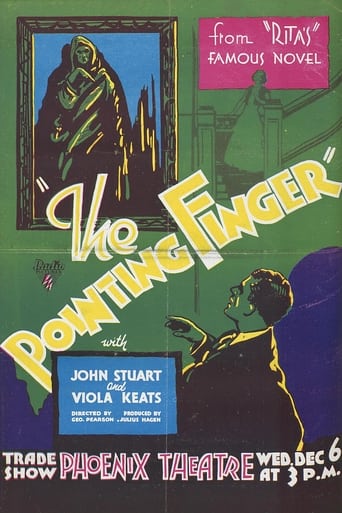hwg1957-102-265704
'The Pointing Finger' is based on "the famous novel" by the modestly named 'Rita'. (Eliza Margaret Humphries to her friends) and probably is more coherent than this 1933 film version. At the end one was thinking, 'yes, but' and 'does that mean?' and 'what was that about?' and so forth. For example the Edensore family is haunted by a pointing abbot in a habit who frightens the male members of the family to death but at the end it transpires the habit is a real one so who has been wearing the habit in the past hauntings. The secret passed on from one heir to the next is the location of the habit so do the young heirs frighten the old ones to gain their inheritance? One of the characters says the above line about the other side of a tapestry but that indeed is where the habit is stored so does she know about it all or was that a chance remark? I'm thinking too much about this...It is a slow moving film set mostly in one house with not much excitement despite the convoluted plot. The acting is very much of its time. Michael Hogan as the ambiguous Patrick Lafone (you know he's Irish because he says 'bejabers') is the most interesting character.
skiddoo
I tend to agree with the more positive comments under the video online. The story has a few suspenseful moments and several twists. Why does the heir come back not knowing anything about the curse but knowing about a certain poem? What part do the low life criminals play? What part does the greedy potential heir play? What part does Africa play? What will happen with the "pal" who welcomed home her very different friend? This is a British production. We have friendly and "rebellious" South African natives and an admiration for Cecil Rhodes. We have a bad Irishman who turned out to be a good Irishman under the influence of a friendship with an English gentleman. (Some hope in that for the Republic of Ireland getting along with the UK--acting like a gentleman is more important than ethnicity?) We have an Englishman born in South Africa with an English accent who is a part of some sort of militia to put down uprisings against their rule. We have an Englishman born in England with the same accent who appears to want to simply hang out in Africa indefinitely, I suppose living off his father's money, the idle rich. One might suggest that the movie promotes the British colonization of South Africa. One might also suggest the movie promotes the idea that if you are born to wealth you should be doing something constructive with your life, not avoiding your responsibility. This reminds me of the Poirot story with the South African mystery. Apparently in South Africa secrets could abound because it was so far from Britain. Unhappily for some of the characters, what happened in South Africa didn't stay in South Africa.
malcolmgsw
George Pearson was one of the pioneers of the British film industry.he made his first film in 1913.However by the time he directed this film he was on his uppers.this film was one of no less than 5 that he directed in 1934.By 1936 he would make his feature film.This film is typical of the quota quickies turned out by Julius Hagen at Twickenham studios.It lasts 66 minutes and would have been sold to distributors ,Radio, for £6600 that is £1 per foot.The film utilises all the devices for quick filming.Not many close ups.Scenes done in one long take.There is one scene where there are 3 actors in the shot.Only the woman on the right edge of the frame is partly out of shot,clearly an error,but one which they chose not to rectify.The plot itself is quite strange and rather convoluted.Parts of the denouement are downright ridiculous.However for anyone interested in these type of films it will nonetheless provide interesting viewing.
JohnHowardReid
From Alpha comes "The Pointing Finger" (1933) which, despite its long introductory sequence in which the role of the Pointing Finger in the family curse is explained at great length, is not a horror film at all. For soon after the introductory scenes (which have bored us stiff while we imbibe all the instant information), the story changes tack completely. In fact, the movie hardly qualifies as a thriller. It's actually one of those look-a-like yarns which used to be very popular with egotistical actors (it gives them the opportunity to play TWO roles) and Poverty Row producers (two actors for the price of one). Alas, the dull John Stuart plays the dual roles with only middling success for almost all his scenes are stolen by either Michael Hogan (rather ingratiating as a Clayton's villain – i.e. the villain you have when you're not having a villain) or the lovely Viola Keats. True, there's a bit of life in the climax, which even the plodding direction by George Pearson can't quite eliminate, but I doubt if most people will still be watching at this point.



